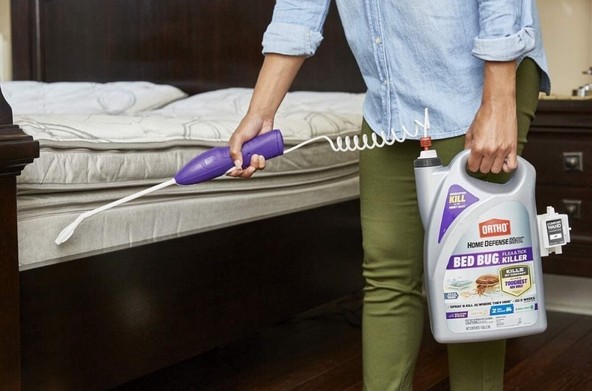The first thought that often comes to mind when encountering bed bugs is bug spray. Bug sprays have been proven to work against other bugs and insects like mosquitoes, mites, cockroaches, and even ants. Bed bugs are tricky since sprays require direct contact to kill them.
While we do not advocate for the use of pesticides due to their environmental and health impacts, there are circumstances when you would need to use a bug spray. This calls for timing, patience, and caution. The article provides further direction on using a bug spray against these bugs.
Table of Contents
What is a bed bug spray?
Bed bug sprays are insecticides, and insect repellants contain pressurized cans to either repel or eliminate insects and bugs. They could be naturally occurring, like essential oils or synthetic, usually more potent. Bed bug sprays are generally great for outdoor activities that require a lot of movement and are especially great when enjoying a summer day.
Bed bug spray insect repellants have low potency as they are applied to your skin to ward off insects. Some variations let you use them on your clothes and backpacks to discourage bugs from landing on you. Bugs locate humans by sensing heat, carbon dioxide, and sometimes pheromones. Repellants mess with bug senses. Bed bug sprays that work to repel bugs are sprayed onto the skin to ward them away.
On the other hand, bed bug sprays containing insecticides have insecticidal properties that kill bugs. These cannot and should not be applied to the skin as they could cause adverse reactions. Most often, you will need to spray them directly onto the bugs to kill them. For those insecticides with longer-lasting effects, you can spray them onto bug paths to kill them on contact.
How does a bed bug spray work?
An understanding of this would require an understanding of how pressurized spray cans work. The contents of a bug spray contain insect repellants or insecticides with an addition of a propellant that is either in gas or liquid form. The repellant or insecticide is poured onto the can and sealed. After that, the repellant is pumped into the can at over four times the atmospheric pressure in the environment.
The release trigger is pressing down on the can lid. This mechanism lowers pressure inside the can, creating a ‘boiling effect’ on the insecticides, pushing them upwards. The nozzle is small enough to break insecticide/ repellant onto molecules that come out as mist. Bed bug sprays containing creams use the same principles, except they come out in foam.
Repellants do not need necessarily need direct contact to keep insects from you. They create a barrier on your skin, affecting the bug’s ability to locate you for feeding. On the other hand, insecticides may only be effective if it comes in contact with bugs.
Are bed bug sprays effective?
Bed bug sprays do not offer a hundred percent protection against bed bugs. Especially considering the kind of evolution journey of bed bugs that have rendered past working methods like some diatomaceous earth useless, nothing short of magic would be perfect against bed bugs. Repellants work even better than insecticides. A study shows that repellants like oregano will have over 98% potency within 24 hours.
Many factors will determine the effectiveness of a bed bug spray against bed bugs. The potency of the insecticide or pesticide will determine how well the bed bug spray works. Most often, purely organic pesticides will work less than synthetically made ones that bed bug extermination professionals usually use. Previous applications may render reduce the effectiveness of your bug spray. Some bug sprays work well against one species of bed bug than the other.
Are bed bug sprays harmful?
Bed bug sprays, especially those containing insecticides, could be harmful if applied to your skin. However, repellants are safer in application. Different people will have different reactions to even bed bug spray repellants. Some people can have mild skin reactions like irritations and swelling, while others can have more severe once likes seizures and breathing problems. Plant-based bug sprays are safer for humans. It would be wise to follow the directions on the label.
Practicing safe applications and reading labels will keep you safe. Plant-based insecticides like essential oils may offer better and safer protection against bed bugs. Pay attention to your body’s reaction to repellants. Stop using the bug spray repellant if the application causes even a tiny reaction like irritation.
Application of the regular bed bug spray should be subject to the infestation size, bed bug age, area of infestation, and possible reactions to its use. There are cases of these sprays working well but causing discomfort in humans and pets. It is best to spray directly onto the infestation zone. It would also be wise to use safer organic or plant-based options around your sleeping area while saving the more potent ones in regions with minimum human and pet presence.
How to apply bed bug sprays
Bed bug sprays are not the best treatment option, but some circumstances can force you to use them. Here are some steps that you should follow when applying bed bug sprays to ensure everything goes smoothly:
- The first and probably the most critical step is to read over the bed bug spray label. It establishes the type of insecticides contained and the amount needed for effective and safe applications.
- Depending on the type of bed bug spray, it is vital to shake the bottle up to mix the ingredients well and to avoid sedimentation at the bottom of the can.
- If you have the powdered options, pour the powder into the spray can, add a little water, shake it well, then apply all the remaining water as directed on the label.
- Tilt the nozzle towards the infestation area and spray evenly. You may need to spray it at intervals, mainly if you use a spray can to create effectiveness. Pressurized ones like aerosol cans are easier to even out within the infested zone’s grooves, cracks, and surface.
- Take care not to tilt too much since it levels out the atmospheric pressure inside, making it difficult to spray evenly and well.
- Depending on the label, you may need to keep the room windows and door closed for maximum and long-lasting effectiveness upon leaving the room. However, once you are ready to use the space, open the window and door for maximum aeration and reduce the chances of having adverse side effects like breathing problems.
On the other hand, bed bug spray repellants are easier to apply. Before going onto an excursion or accessing a potential bed bug infestation zone, apply bed bug cream and spray it onto your skin and clothes. Take care not to ruin the fabric of your bug and clothes with stains. Check the label to see any warnings about this. Discontinue any further usage if you experience any additional side effects.
How to make natural bed bug spray
The kind of bed bug spray you will make will depend on a can, propellant, and suitable insecticide availability. This also means that the infestation zone and size would influence the choice and amount of insecticide used. Read the label of the packet or container. This should not be skipped as the law requires any subsequent application to be done as directed on the label. Follow this direction;
- For your choice of insecticides, you have your average essential oils, alcohol, natural oils, and vinegar.
- For the vinegar, you may need even more for higher efficacy against bed bugs. Use a clean spray can and pour the ingredients into the can. Use five drops of either the alcohol.
- After that, add water to the bottle and shake for thirty seconds or until there is an even mixture. If there is sedimentation, you may need to add more water.
- Spray onto the infested area evenly, concentrating on high-infestation zones.
- Do this for a week to kill bed bugs
Final thoughts
Bed bugs are annoying critters that can badly affect your life. The most effective ways to eliminate them, including bed bug infestation professionals, are too expensive or inaccessible to you. Fortunately, there are Do-It-Yourself bed bug treatment options that you can use to eliminate them. Many factors will determine your choice, including infestation size, time, and resources. Spray cans are a fast and available option for handling bed bugs. Mix the ingredients as directed and apply well and consistently.
FAQs
Can bed bug sprays harm your pet?
Yes. Bed bugs can be harmful to you and your pets. Practice safe applications taking note of body comfort.
Where can you get bed bug sprays?
Bed bug sprays are readily available in your local retailers and supermarkets. Online retailers like Amazon can get them to you too.
Do sprays destroy bed bug eggs?
No. Bed bug eggs are harder to destroy. Other options like silica and heat treatment would better serve you.

